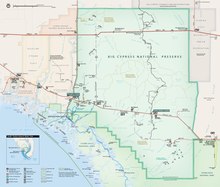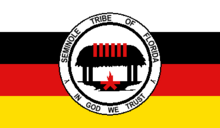
Clewiston is a city in Hendry County, Florida, United States. Its location is 80 miles (130 km) northwest of Fort Lauderdale on the Atlantic coastal plain. The population was 7,327 at the 2020 census, up from 7,155 at the 2010 census. The estimated population in 2018 was 7,985. The city is located on the south bank of Lake Okeechobee, and the Lake Okeechobee Scenic Trail (LOST) passes through the edge of the city. The city is home to Billie Swamp Safari, the Clewiston Museum and the Dixie Crystal Theatre. The area has been home to Seminole tribe members and sugar plantations, with the Ah-Tah-Thi-Ki Seminole Indian Museum located 32 miles (51 km) south of the city.

The term Five Civilized Tribes was applied by European Americans in the colonial and early federal period in the history of the United States to the five major Native American nations in the Southeast, the Cherokee, Chickasaw, Choctaw, Muscogee, and Seminoles. Americans of European descent classified them as "civilized" because they had adopted attributes of the Anglo-American culture.

The Seminoles are a Native American people who developed in Florida in the 18th century. Today, they live in Oklahoma and Florida, and comprise three federally recognized tribes: the Seminole Nation of Oklahoma, the Seminole Tribe of Florida, and the Miccosukee Tribe of Indians of Florida, as well as independent groups. The Seminole people emerged in a process of ethnogenesis from various Native American groups who settled in Spanish Florida beginning in the early 1700s, most significantly northern Muscogee Creeks from what is now Georgia and Alabama.

Brighton Seminole Indian Reservation is an Indian reservation of the Seminole Tribe of Florida, located in northeast Glades County near the northwest shore of Lake Okeechobee. It is one of six reservations held in trust by the federal government for this tribe. The reservation has a land area of approximately 146 square kilometers or 36,000 acres and a 2000 census resident population of 566 persons.

Chikee or Chickee is a shelter supported by posts, with a raised floor, a thatched roof and open sides. Chickees are also known as chickee huts, stilt houses, or platform dwellings. The chickee style of architecture—palmetto thatch over a bald cypress log frame—was adopted by Seminoles during the Second (1835–42) and Third (1855-58) Seminole Wars as U.S. troops pushed them deeper into the Everglades and surrounding territory. Before the Second Seminole War, the Seminoles had lived in log cabins. Similar structures were used by the tribes in south Florida when the Spanish first arrived in the 16th century. Each chickee had its own purpose and together they were organized within a camp-type community. Chickees were used for cooking, sleeping, and eating.

Big Cypress National Preserve is a United States National Preserve located in South Florida, about 45 miles west of Miami on the Atlantic coastal plain. The 720,000-acre (2,900 km2) Big Cypress, along with Big Thicket National Preserve in Texas, became the first national preserves in the United States National Park System when they were established on October 11, 1974. In 2008, Florida film producer Elam Stoltzfus featured the preserve in a PBS documentary.

The Miccosukee Tribe of Indians of Florida is a federally recognized Native American tribe in the U.S. state of Florida. They were part of the Seminole nation until the mid-20th century, when they organized as an independent tribe, receiving federal recognition in 1962. The Miccosukee speak the Mikasuki language, which is mutually intelligible with the Hitchiti language, is considered its dialect, and is also spoken by many Florida Seminole.
The Mikasuki, Hitchiti-Mikasuki, or Hitchiti language is a language or a pair of dialects or closely related languages that belong to the Muskogean languages family. As of 2014, Mikasuki was spoken by around 290 people in southern Florida. Along with the Cow Creek Seminole dialect of Muscogee, it is also known as Seminole. It is spoken by members of the Miccosukee tribe and of the Seminole Tribe of Florida. The extinct Hitchiti was a mutually intelligible dialect of or the ancestor of Mikasuki.
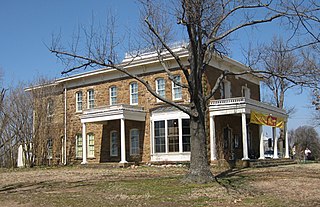
The Five Civilized Tribes Museum in Muskogee, Oklahoma, showcases the art, history, and culture of the so-called "Five Civilized Tribes": the Cherokee, Chickasaw, Choctaw, Muscogee (Creek), and Seminole tribes. Housed in the historic Union Indian Agency building, the museum opened in 1966.

The Big Cypress Indian Reservation is one of the six reservations of the Seminole Tribe of Florida. It is located in southeastern Hendry County and northwestern Broward County, in southern Florida, United States. Its location is on the Atlantic coastal plain. This reservation lies south of Lake Okeechobee and just north of Alligator Alley. It is governed by the Seminole Tribe of Florida's Tribal Council, and is the largest of the five Seminole reservations in the state. Facilities on the reservation include the tribal museum and a major entertainment and rodeo complex.
Ar-pi-uck-i, also known as Abiaka or Sam Jones, was a powerful spiritual alektca and war chief of the Miccosukee, a Seminole–Muscogee Creek tribe of the Southeast United States. Ar-pi-uck-i successfully defied the U.S. government and refused to remove to the Indian Territory west of the Mississippi and his influential leadership in the Second Seminole War (1835–1842) resulted in the permanent Native American presence in Florida.
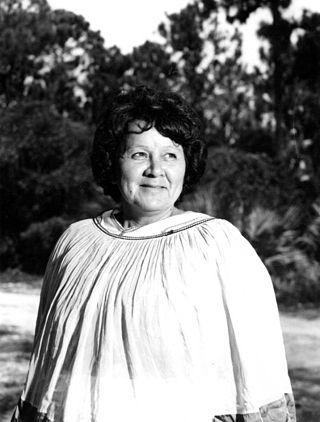
Betty Mae Tiger Jumper, also known as Potackee (Seminole), was the first and so far the only female chairperson of the Seminole Tribe of Florida. A nurse, she co-founded the tribe's first newspaper in 1956, the Seminole News, later replaced by The Seminole Tribune, for which she served as editor, winning a Lifetime Achievement Award from the Native American Journalists Association. In 2001 she published her memoir, entitled A Seminole Legend.
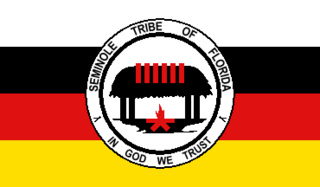
The Seminole Tribe of Florida is a federally recognized Seminole tribe based in the U.S. state of Florida. Together with the Seminole Nation of Oklahoma and the Miccosukee Tribe of Indians of Florida, it is one of three federally recognized Seminole entities. It received that status in 1957. Today, it has six Indian reservations in Florida.

The Seminole Nation of Oklahoma is a federally recognized Native American tribe based in the U.S. state of Oklahoma. It is the largest of the three federally recognized Seminole governments, which include the Seminole Tribe of Florida and the Miccosukee Tribe of Indians of Florida. Its members are descendants of the 3,000 Seminoles who were forcibly removed from Florida to Indian Territory, along with 800 Black Seminoles, after the Second Seminole War. The Seminole Nation of Oklahoma is headquartered in Wewoka within Seminole County, Oklahoma. Of 18,800 enrolled tribal members, 13,533 live in Oklahoma. The tribe began to revive its government in 1936 under the Indian Reorganization Act. While its reservation was originally larger, today the tribal jurisdictional area covers Seminole County, Oklahoma, within which it has a variety of properties.

The Tampa Reservation is one of six Seminole Indian reservations governed by the federally recognized Seminole Tribe of Florida. It is located in Hillsborough County, Florida.
William Buffalo Tiger was a political leader of the Miccosukee Nation based in the Everglades area of Florida. He served as the first elected tribal chairman from 1962 to 1985, and before that was head of the General Council from 1957 and a chief. His activism led to political organization of the Miccosukee and their gaining federal recognition in 1962 as an independent Native American tribe. They wrote a constitution to govern their people.
Chief Joe Dan Osceola was the chief and ambassador of the Native American Seminole tribe. He was the appointed Seminole Tribal Ambassador, who held the position of the youngest Chief and Tribal President, elected in Seminole history. Chief Joe Dan Osceola was the great-great-great-grandson of Chief Osceola, "Unconquered Chief".

Billy Osceola, was the first elected chief of the Seminole Tribe of Florida. He became an ordained minister and was extremely influential in shifting the Seminole Tribe of Florida from traditional spiritual practices to the Baptist faith. He was the first elected chairman of the tribe after their 1957 reorganization.

Josie Billie was a Mikasuki-speaking Seminole medicine man, doctor, and Baptist preacher. Billie was a member of the Panther clan of the Seminoles in southern Florida. He actively collaborated with American anthropologists and researchers like Ethel Cutler Freeman, Frances Densmore, Robert Greenlee, Robert Solenberger and William Sturtevant. Billie served as a public spokesman for the Florida Seminoles and created recordings of traditional folk songs and information about the traditional Seminole religion. As of 2017, his camp is part of the Tribal Register of Historic Places.

